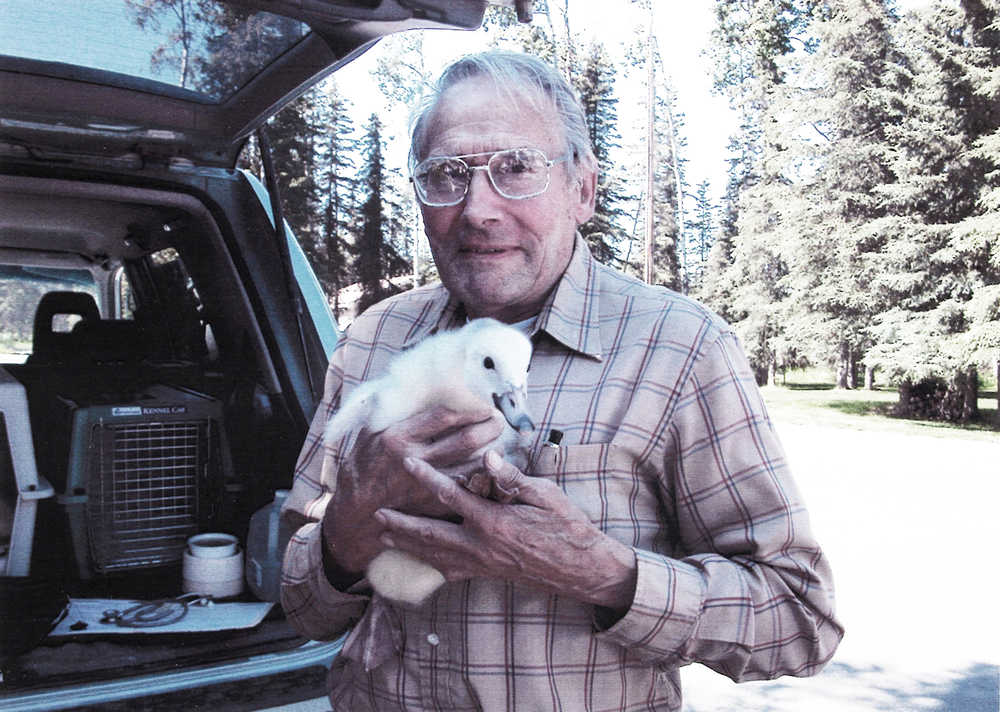Laurie Severe remembers the exact moment her favorite trumpeter swan — with which she had formed a bond stronger than that of animal and caretaker — was ready to hop the pond and take off on its own from her property in Iowa.
Severe, a volunteer for the Iowa Department of Natural Resources, recalled the bird coming around the side of a garage with another swan, which she suspects may have been a male partner.
“She talked and talked and talked to me, and I think she was just saying goodbye,” Severe said.
And just like that, swan No. 69 was gone.
Severe, whose pond on her property in Nora Springs, Iowa is a perfect place to raise young swans, has been a volunteer for the Iowa DNR for about a decade in its swan restoration program. Swan No. 69 was originally brought to her as a cygnet, or baby swan, with its two sibling from none other than the Kenai Peninsula, where the three had been orphaned on a local lake in 2005.
John Morton, supervisory biologist at Kenai National Wildlife Refuge, said Kasilof resident and homesteader George Pollard witnessed a new swan pair coming in and harassing an existing nesting pair and their cygnets on the lake. Eventually, the male, or cob, was killed and the female, called a pen, was run off the lake, according to a refuge notebook article published July 2005.
Refuge staff found three of the swans’ original five cygnets still alive, according to the refuge notebook, and decided to transfer them to the restoration program in Iowa established by the state’s Department of Natural Resources in 1993. Severe remembers the cygnets’ arrival to her pond.
“That group of swans,” she recalled. “They followed me around like little ducks.”
But there was something different about No. 69. Severe said the bird made a habit of coming up and “talking” to her. She formed a unique bond with the bird while she raised it along with the many other cygnets brought to her pond to be restored in the Midwest.
Her work with the program began when Severe noticed a pair of swans who landed at her pond and stuck around, and called the DNR to report them. The organization struck up and agreement with Severe, and she donates the electricity to the now-aerated pond while the DNR supplies food for the young swans, or cygnets, she fosters.
“They bring them in the fall and then I raise them over the winter,” Severe said. “And they come and get them before they molt.”
No. 69 has since migrated and had a brood of her own, but she still comes back every once in a while to visit Severe and the pond where she grew up. Severe thinks the birds remember that her pond is aerated and that it is a place they’re guaranteed to get food.
There are around 20,000 trumpeter swans in Alaska, Morton said, and about 40-50 nesting pairs on the peninsula. Trumpeter swans from Alaska can be particularly useful to restoration programs in the Lower 48, where the birds are considered rare in many areas, because they bring with them genetic diversity and strong migratory instincts, according to the refuge notebook article.
One of these areas where swan populations waned is Iowa, where the restoration program raises trumpeters and then releases them in the northern part of the state. The program’s goals were to establish 15 wild nesting pairs in the state by 2003 and “to use the swans to promote the many values of wetlands not only for wildlife habitat but for water quality and flood reduction,” according to the department’s website.
“The recovery objectives for Iowa were actually fairly modest,” Morton said. “When these (cygnets) went down in 2005 they were kind of in the middle of it. It didn’t take them very long to get there.”
Morton said the addition of Alaska trumpeters to the Midwest populations helps create a more resilient stock. Alaska is considered one of the major producers of swan species — trumpeters and tundra swans — Morton said, and can lend a hand to small, recovering breeding populations in the Lower 48.
“The Alaska population as a whole has just taken off,” he said. “But on the Kenai, we’ve done a lot of work over the years … we actually have a lot of regulations in place to protect swans.”
Despite this work, Morton said it appears the peninsula has reached some kind of cap as to the amount of breeding among swans, and that about 50 breeding pairs isn’t a large number. There has been growth, however, in individual, non-breeding swans, he said.
Severe, a self-described nature lover, said she has enjoyed her volunteer work with the birds over the years. She said all her neighbors are well aware of her work with the DNR.
“They just call me the crazy bird lady,” Severe joked.
She still recognizes the orphaned swan siblings when they stop by for a visit, and especially appreciates time with her favorite, she said.
“She made an impression on me forever,” Severe said. “I’ll never forget those times sitting on the beach with her nibbling on my hair.”

